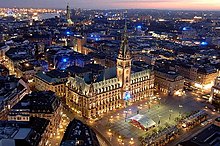Blue Goal


The Blue Goals ( English for Blue gates were) a series of light installations in Hamburg to the 2006 FIFA World Cup should join. The theater maker and light artist Michael Batz was responsible for this light art project . Together with Andreas Mattner , the managing director of ECE Projektmanagement , he developed this project for the city of Hamburg, which in the summer of 2006 was a particular eye-catcher in the context of the soccer world championship.
Until the start of the soccer world championship, 165 of these blue goals spread a blue light in all parts of Hamburg at night. Many Hamburg companies had acquired such a Blue Goal. On June 20, 2005, the first Blue Goal was set up on the ECE Projektmanagement building. After that, several more doors were added, for example on the roofs of the Gruner + Jahr publishing house , the Axel Springer building , the Hamburg-Mannheimer insurance company or the Philips headquarters . Other Blue Goals were among others at Hamburg Airport , the central mosque on Böckmannstrasse, the Hamburg Chamber of Commerce , the Bacardi Tower , the Airbus A380 production site and the Hotel Atlantic . On May 11, 2006, the 111th Gate, the highest Blue Goal in Hamburg at 120 meters above sea level, was inaugurated on the main administration building of Euler Hermes Kreditversicherung . A special Blue Goal, the 165th by then, was put into operation on June 8th. It spanned the tracks of the Hamburger Hochbahn at the St. Pauli Landungsbrücken so that the trains on the “U3” line passed through this gate.
The Blue Goals consisted of aluminum crossbars that were firmly anchored or screwed to the ground. The illumination was done by blue fluorescent tubes. The goals could have different dimensions depending on the location, so blue goals with a height of up to 15 meters were possible. The normal gate was 5.00 meters high and 6.5 meters wide, while the largest on the dry dock at Blohm + Voss was 50.00 meters high and 80.00 meters wide. The average costs for a Blue Goal were between 4,000 and 6,000 euros . “Mini Blue Goals” measuring 18 by 30 centimeters were also sold for 149 euros.
During the entire time of the World Cup , shots at the goals were symbolized by laser beams from various urban landmarks every day at 11 p.m. for around an hour .
The focal point of the eight planned laser locations were the Mundsburg Towers , which, due to their location in the geographical center of Hamburg, could achieve almost all of the Blue Goals. Despite contradicting information, the installation on the roof of the apartment tower under the leadership of the owner Stephan Philipps was brought to a successful conclusion. The installation of one's own Blue Goal on the Mundsburg was recently not possible due to static uncertainties and police requirements.
On September 30, 2006 the Blue Goals were announced with speeches and a. Farewell to the light artist Michael Batz, music by the colorful dogs and a small firework display over the Inner Alster and the Blue Goals campaign ended. At 7.45 p.m. the Blue Goals also went out with the last fireworks rocket.
literature
- Michael Batz (foreword), Martin Deppner (foreword), Leif Schmodde (photographer): Blue Goal Hamburg , ELPASO, October 2006, ISBN 3-9811306-4-2


